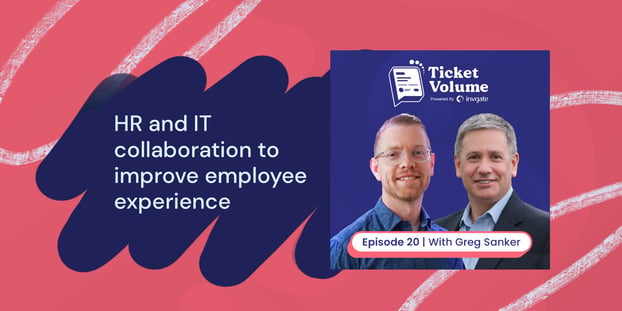HR and IT collaboration may just be the answer to all of your employee experience problems. In a world where team members and companies alike are facing immense challenges with adapting and changing, IT solutions are what the HR department needs to enhance employee experience, and the people element is what the IT department lacks to create a holistic technology solution for everyone.
Employees in an enterprise business have the habit of working in silos, compartmentalized, and separated from other departments. The collaboration between HR and IT would make such a difference in the employee journey, as long as each department is aware of the scope and constraints that employees face every day.
This collaboration enables more agile, efficient, and effective workforce management. This isn't an option; it's a requirement for successful employee experience management. And not just a coworking situation either, HR and IT should cooperate and make an entirely new department that solely focuses on solving these problems. This is, in a nutshell, Greg Sanker’s big radical idea.
Greg Sanker is our special guest for the 20th episode of Ticket Volume, our tech podcast for Service Management professionals hosted by Matt Beran. He is the Director of IT Support at Taylor Morrison and has more than 10 years of experience as a consultant, speaker, and author in the ITSM industry. Sanker is an expert in ITIL, Organizational Management of Change, Global IT Operations, IT Operations Management, and Business Processes Alignment.
Keep reading to find out his suggestions on what challenges companies have to face in order to make HR and IT collaboration happen, and how best to do it.
HR and IT are working towards the same goal
Nobody says it better than Sanker:
|
|
"We’ve been increasingly aware that there is a cultural element associated with the technology that we use. (...) What we quickly learned is that [the resistance to using modern collaboration suite software] wasn’t an implementation issue, this was a culture issue. (...) The technology by itself wasn’t really doing anything for us. So why do we deploy collaboration suites? We think we’re increasing productivity, and we think we’re increasing collaboration, but by itself, it doesn’t." Greg Sanker |
Greg Sanker came to the above conclusion after a series of instances where he worked with management teams to roll out a new collaboration tool. When it comes to implementing new technology solutions for old-fashioned corporate culture, change management can be a huge challenge. And this change cannot be addressed by the HR or IT department separately; it has to be a joint effort.
At first glance, HR and IT can be so different. One is people-centric, is supposed to be flexible, and takes care of employee engagement, while the other is rigid, data-driven, and is supposed to adhere to systems and structures. However, Sanker pointed out that HR and IT have more in common than we would think.
According to research by CIO.com, the top seven things that CIOs are concerned about include: talent acquisition, skills gap, hybrid work, cyber security, tech supply chain, employee burnout, and managing organizational change. Clearly, IT is not only about technology and innovation, for five of the seven concerns are not tech-related. They are interested in how to create the best digital workplace for the employees just as much as the HR department is, by putting real efforts into shortening the skills gap, managing recruitment and retention, and accommodating hybrid work.
On the other hand, CHROs are interested in much more than just recruitment and employee engagement. They are also hands-on in making the workplace more friendly for hybrid work and change management for better experience and performance.
The approach of each department can be different, but they are working together to achieve the same goal, which is an overall better employee experience, even from pre-boarding, onboarding, all the way to offboarding. They are both aware of the needs of employees and informed about the potential restrictions or limitations that may derail the offered solution by working collaboratively.
Most solutions may be achieved using several techniques, and with open communication between HR and IT, a working solution can be conceived, tested, and deployed. Installing a new HR tech without the help of IT can lead to defects or total incompatibility, and trying to get IT people to communicate effectively with other company members without HR can also be a big challenge.
|
|
"We can’t separate the culture from the technology and we can’t separate the technology from the culture." Greg Sanker |
3 challenges of HR and IT collaboration
Innovation and collaboration always come with challenges. In the case of HR and IT, it’s technically the fundamental difference in how we perceive both departments that created these obstacles. Let’s explore some of the most common challenges that a collaboration between HR and IT may face, both in the proposing and implementation phase.
The current differences in skill sets
The demands in the job descriptions for these departments haven’t strayed too far away from what they originally were. IT people are asked to be systematic, and tech-savvy, but they don’t have to be people-centric, whereas HR people are allowed to be a bit slower with technology, but their internal communication skills and people-first mentality have to be prominent.
This rigidness in how we perceive HR and IT is creating a wall between these positions, making them grow in opposite directions and the process of combining skill sets can be harder than ever.
Resistance to old habits
Once a certain behavior has made its way into the corporate culture, any change can be met with strong resistance. An instance Sanker gave in the episode illustrated clearly that even though this organization is given a modern collaboration suite, they could not shake off old habits of working independently, which defeats the purpose of team collaboration. In this case, technology was never the problem, but the culture was too prominent in this old-fashioned organization.
Working in silos
So often we see companies be separated into offices, cubicles, and departments, which may perpetuate the silo-working mentality for a lot of people. The physical separation does not give room for agility and cross-functional collaboration. Plus, it can deny employees any chance of effective communication. For two departments that are so different like HR and IT, this makes collaboration even harder.

3 ideas for HR and IT collaboration success
Overcoming these challenges is a team effort. In the episode, Greg Sanker proposed a few ideas that IT and HR managers can implement to achieve the best business outcomes from this collaboration.
1. Apply design thinking
Design thinking principles rely less on pre-determined structures and more on the user experience. HR and IT collaboration should be motivated by a desire to understand the job of the people whose circumstances this collaboration is attempting to improve. Understanding their processes, constraints (both technically and personally), and how this will feed their ambitions as an employee as well as the company's goals should all be considered.
2. Encourage hands-on governance
As explained earlier, rigid structures and collaboration plans are some of the biggest obstacles to this process. Top-down management no longer performs well in a company that wants to succeed in this technological climate. Sanker suggests that instead of perpetuating a silo structure, it’s better to encourage everyone in the organization to be hands-on in the process of collaboration. The constant problem-solution-feedback flow will keep the company running and everybody on board. This doesn’t only ensure a smooth collaboration process but is also a great practice to improve the employee retention rate.
3. Be outcome-driven
Set goals, and be driven by the business goals you’ve set. That’s what this is all about. HR and IT collaboration, after all, is a vessel that helps employees perform better, more effectively, and efficiently.
In this sense, Sanker realized that the best-performing leaders across industries did not focus on the tools, but instead on the tasks and goals, with which tools are useful. This mentality has helped shape some of the most driven people and the most successful companies.
The future of digital workplace experience
People, culture, and technology are not to be treated separately, especially in this era of constant changes. To our guest, Greg Sanker, HR and IT collaboration is among the most effective ways to skyrocket the performance of the team through enhancing the employee experience.
Though there are many challenges to be addressed during the process, with a team effort, the right implementation of design thinking, and an outcome-driven mentality, this collaboration is the key to any successful organization in the future.















